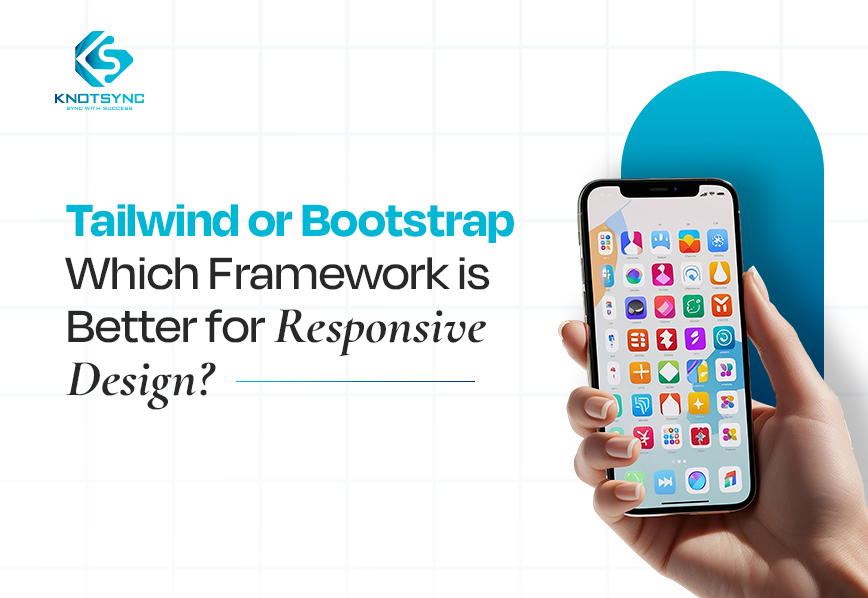In today’s highly advanced web world, responsive web design is crucial for any business success. Are you aware that around 90% of websites have implemented responsive design? This is because it improves user experience and aids in better audience reach. While there are many responsive design frameworks that you can choose from, here we will learn about tailwind vs bootstrap.
What is Tailwind CSS?
Tailwind CSS is a utility-first CSS framework that helps developers build websites quickly and easily. By utility-first class, the framework offers utility classes so you can create your own website components. It is a widely used framework that provides you with flexibility and highly customization options, unlike any other CSS framework. Such features allow you to create a more unique website. This CSS framework is packed with classes like flex, pt-4, rotate-90 and text-center.
Further, the tailwind framework is fast, flexible and reliable that has zero-runtime. All in all, it is a powerful framework that minimizes the need to write codes which helps make your work easy and fast.
What is Bootstrap?
Bootstrap is the most popular HTML, CSS and JavaScript framework that is used for building responsive mobile first projects on the web. It is a framework known for its responsiveness and easy-to-use file structure. It has a broad browser compatibility that makes it compatible with a wide range of browsers.
Moreover, with bootstrap, you can reduce your burden of coding from scratch as it offers ready-made coding blocks.
Just like tailwind, bootstrap also comes with highly customizable options. If in any case, you do not have the time to start coding from scratch, it offers you the chance to blend your existing codes with customizations.
What is the Difference Between Tailwind and Bootstrap Framework: Tailwind CSS vs Bootstrap
Many times, there has been a debate on Tailwind CSS vs. Bootstrap as to which one is a better framework. Tailwind offers a utility-first approach that allows for complete design control without the need to write custom CSS. On the other hand, Bootstrap comes with ready-to-use components that make it easy to create a website, catering to different stages of website development. Let us see some key differences between the two and understand which one is better Tailwind CSS vs Bootstrap:
| Feature | Tailwind CSS | Bootstrap |
| Design Approach | Utility-first | Component-based |
| CSS File Size | Smaller as unused classes can be purged | Larger and includes all component styles even if unused |
| Predefined Components | Does not offer ready-made components | Offers a wide range of components such as buttons, modals etc. |
| Customization | Highly customizable | Offers customization but in predefined styles |
| Documentation Quality | A comprehensive and well-maintained documentation | An extensive, well-organized and updated documentation |
| Responsiveness | Highly responsive | Built- in responsive grid and components |
| Flexibility | Very flexible and build custom designs easily | Less flexible due to predefined structures |
Now let us go through these differences in detail.
Design Approach
Tailwind offers the utility-first approach that includes utility classes which define specific styles. You can build your design from scratch using these utility classes and get full design control without writing custom CSS.
Bootstrap has a component-based design approach that comes with pre-styled components such as buttons and grids. The framework provides you with in-built design that allows you to build applications easily.
CSS File Size
The CSS file size for tailwind is smaller as it includes PurgeCSS to remove unused classes. This results in small, purged file sizes and faster load times.
On the other hand, the CSS file size for bootstrap is usually larger. This is because it includes styles for a variety of components which makes the file size bulky until it is manually customized.
Predefined Components
Tailwind does not include any predefined components, instead it provides utility classes. This does allow for more flexibility but leads to more manual work if you want ready-made components.
Bootstrap on the other hand provides a rich library of pre-built components. These include modals, buttons, cards etc. These components in bootstrap make it easier for developers to create a well-designed look of the website.
Customization
The tailwind framework is highly customizable that lets you define your preferred colors, spacing and fonts. You get complete control and can tailor the unique designs as per your needs.
Just like the tailwind, bootstrap also allows for customizations. But bootstrap comes with a default theme that allows customization by modifying variables in SCSS files. Moreover, it offers customization, but you also have to write additional CSS in order to change designs completely.
Documentation Quality
Tailwind has a comprehensive and well-maintained documentation that covers every utility class. It has clear examples, explanations and includes strategies for optimizing CSS size.
The bootstrap also has high quality documentation which is well maintained. It covers both CSS and Javascript components and has lots of examples on how to use components, customize themes etc.
Responsiveness
Tailwind CSS is highly responsive because of the utility classes. It is flexible and has a mobile friendly approach with responsive modifiers. Moreover, it lets the developers customize the feel and look for various breakpoints.
Bootstrap offers a built-in responsive grid and components that allow for easy layout changes. It is also highly responsive and is an excellent choice for rapid development of responsive sites.
Flexibility
Tailwind is very flexible and builds custom designs easily. It allows you full control to design anything from scratch which makes it ideal for custom designs.
Bootstrap, on the other hand, is less flexible due to predefined structures and component styles. For any radical changes, you may need to write additional CSS as it is more rigid than tailwind.
Which Framework is Better? Tailwind vs Bootstrap
While both tailwind and bootstrap are powerful tools that offer customizations and responsiveness. But choosing between the two will depend upon your project needs and personal preferences. If you are looking for a quick, pre-styled grid system where you get a consistent look, choose bootstrap. But if you want enhanced control over your design and a highly customizable framework, then choose tailwind CSS.
Let’s Wrap Up!
In this blog, we tried to give a widened view of the two most used responsive design frameworks i.e. tailwind and bootstrap. While bootstrap’s pre-built components allows developers to easily integrate into an application, tailwind CSS requires the developers to master in the utility classes.
Overall, we can conclude that both the frameworks are a great choice when you are planning to build mobile applications, making them ideal for mobile app development frameworks. To make a choice and see which one is better, you can experiment with their features to see which one aligns more with your needs.




